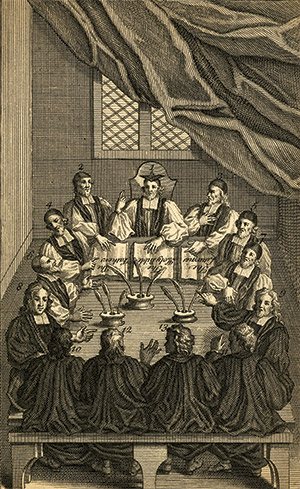The relationship between religion and rationality
was an intimate one in 17th-century England. Christopher J. Walker
looks at the arguments and controversies of the time, which helped to
forge a more open society.
 'The
Compilers of the English Liturgy', a print by Michael van der Gucht,
c.1690. Thomas Cranmer sits at the head of the table. British MuseumIn
early modern England reason was often an accompaniment to religion, a
resource existing alongside faith rather than a force in opposition. In
the English context the two were not always at war. Even before the
Reformation, Erasmus was, in his calm and ironic manner, along with his
contemporaries Thomas More, John Linacre and William Grocyn, promoting
rational religion: that is, Christianity accepted because it was
reasonable and sensible, not merely because it was derived from
revelation and authority. The legacy of this approach can be seen in the
quiet and sensible moderation of much of Anglicanism today.
'The
Compilers of the English Liturgy', a print by Michael van der Gucht,
c.1690. Thomas Cranmer sits at the head of the table. British MuseumIn
early modern England reason was often an accompaniment to religion, a
resource existing alongside faith rather than a force in opposition. In
the English context the two were not always at war. Even before the
Reformation, Erasmus was, in his calm and ironic manner, along with his
contemporaries Thomas More, John Linacre and William Grocyn, promoting
rational religion: that is, Christianity accepted because it was
reasonable and sensible, not merely because it was derived from
revelation and authority. The legacy of this approach can be seen in the
quiet and sensible moderation of much of Anglicanism today.Conflict expelled reason. It had to go into hiding in the turbulence associated with the Reformation of the early 16th century. The storms surrounding competing religious ideologies were too ferocious for anything as mild as reason. Religion became doctrinal, defensive and embattled. The situation had grown calm by the 1590s, when Elizabeth I felt able to reject the ‘Lambeth Articles’, gloomy texts of predestination and human powerlessness, which might have turned England into a grim replica of Calvin’s Geneva of 60 years earlier. A place for reason was apparent two years later in the text of Richard Hooker’s Laws of Ecclesiastical Polity, which proclaimed the virtues of private judgment and rational assent to faith.
Read the full text of this article in the current issue of History Today, which is out now in newsstands and on the digital edition for iPad, Android tablet or Kindle Fire.
No comments:
Post a Comment